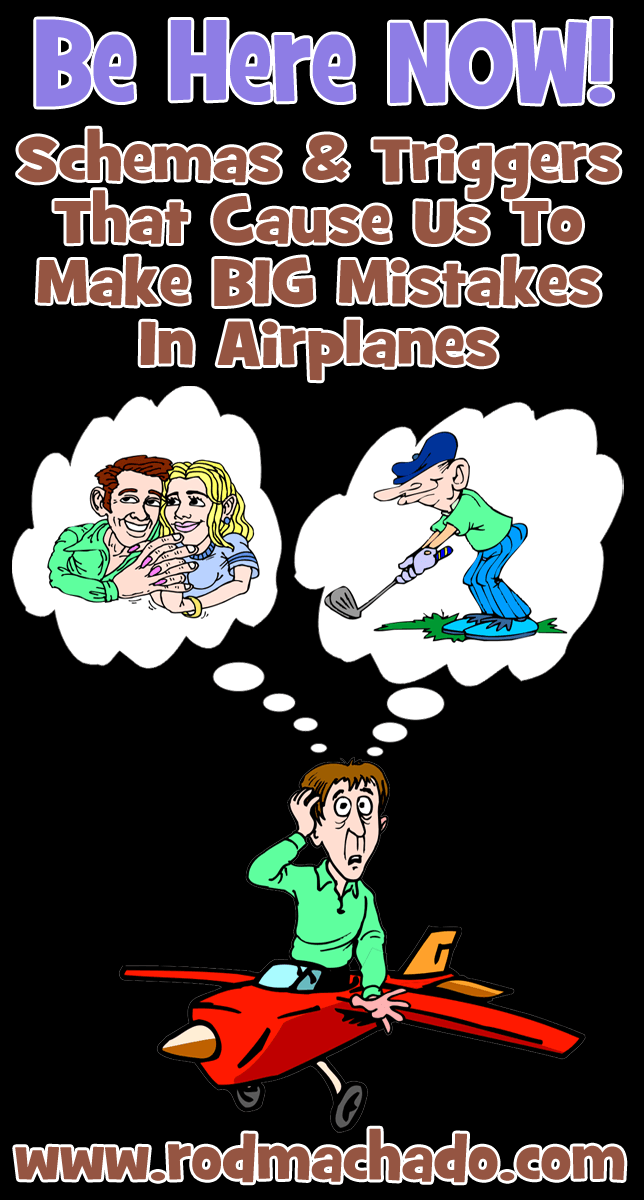By Rod Machado
 Over the years, I’ve seen my grandfather do a number of strange things. One time, while watching football on TV, he sat there yelling at the players. I couldn’t help but say, “Grandpa, they can’t hear you.”
Over the years, I’ve seen my grandfather do a number of strange things. One time, while watching football on TV, he sat there yelling at the players. I couldn’t help but say, “Grandpa, they can’t hear you.”
He replied, “Oh yeah, that’s right, they got their helmets on.”
An even stranger event occurred during a family dinner. Grandpa (still sharp in mind and spirit) filled up his plate with food, grabbed a fork, walked by the sink and promptly emptied his plate into the basin. Acting as if he was washing dishes, he caught himself in the act but not before Grandma began yelling at him. I don’t recall what Grandpa did next, but I suspect he wished he was wearing a football helmet.
Have you ever made a similar error that altered your intended behavior? If so, then you’ve been the victim of one of four common errors that affect our behavioral schemas—these are behavioral programs that run in the background of our consciousness and govern our everyday actions. To understand how these errors affect those of us who fly airplanes, we need to examine how schemas actually work.
Schemas are commonly triggered by one of three things: a memory, an external stimulus or an act of will. When triggered, one or more of the many reflexive behavioral programs stored in our brain begins to play out. Unfortunately, our schemas are sometimes hindered or altered by other triggers. This is exactly what happened to Grandpa. He was running the “get your food and sit down to eat” schema when he walked by the sink (an external stimulus) that triggered his “dishwashing” schema. One schema was altered or captured by another, which is why Dr. Donald A. Norman of Northwestern University calls this the capture error.
Trigger a well-formed habit and it will capture your behavior, which is exactly what standing next to a sink with a plate full of food did to Grandpa. Something similar happens to pilots during an instrument approach when they pop out of a cloud and dive for the first airport they spy. The sight of a runway—any runway—seems to trigger our landing gland, despite that airport not resting at the end of the electronic rail we’ve flown for guidance. More than one 747 approaching Los Angeles has popped out of the clouds only to dive toward and terrorize the folks at tiny little Hawthorne field, which lies a few miles east of the international complex. The general rule here is that if your airliner doesn’t look anything like the other machines at the airport, then you shouldn’t land there.
Another type of error occurs when we form a description of new information on too abstract a level for it to help us run the appropriate behavioral schema. This is called the description error, and it’s our way of minimizing our mental workload. You’ve probably experienced a similar error when you checked your destination airport weather before a flight and heard that the winds would be gusting to 25 knots after a frontal passage. The higher level of abstraction here occurs when you simply equate your previously proven ability to land in gusting winds at a familiar airport but fail to consider other factors. Your abstraction removed the idea that frontal passage usually means a big shift in winds, and that means a crosswind with gusts to 25 knots. Now you’re landing in winds for which you haven’t run your “risk assessment” schema.
Still another type of error affecting our behavioral schemas is known as the selection error. Selection errors often occur when external triggers activate the inappropriate schema. You’ve experienced this if you’ve ever attempted to raise the gear first instead of the flaps during a touch and go landing. The touchdown part of the landing triggers you to do something with your right hand. Unfortunately, some folks do the wrong thing with their right hand.
Finally, when one or more schemas are in play, it’s very easy for you to forget the original intention of your behavior. If you’ve ever walked into a room to get something and forgot why you were there, you’ve just experienced something known as an activation error. Pilots experience something similar when they preflight their airplane for departure, fully intending to obtain fuel in the process. If their “fueling” schema isn’t activated prior to departure, they’ll discover it during cruise flight when the “E” on their heading indicator matches the “E” on their fuel gauge.
So what’s a pilot to do in order to prevent any one or more of these four errors from altering their well intended schemas?
Recognition is the first step. Understanding Dr. Norman’s four categories of errors makes them easier to identify when they occur. It’s the same reasoning behind taking a bird watching class. With a few hours of instruction, the feathery thing you’re pointing to changes from a birdie into a finch.
The next and perhaps most important step is to do what 1960’s Berkeley radical Richard Alpert (aka, Ram Dass) said, and that’s to Be Here Now. Sometimes we just need to pay more attention to what we’re doing at the moment. In cruise flight, you can often be here later, if it pleases you. The closer you are to the ground, however, the more you need to pay attention to what’s happening to you right now. That means monitoring the results of those critical schemas to ensure they’re producing the results you actually intend. Failure to do so in a flying machine often causes pilots to Be Flat Now.

